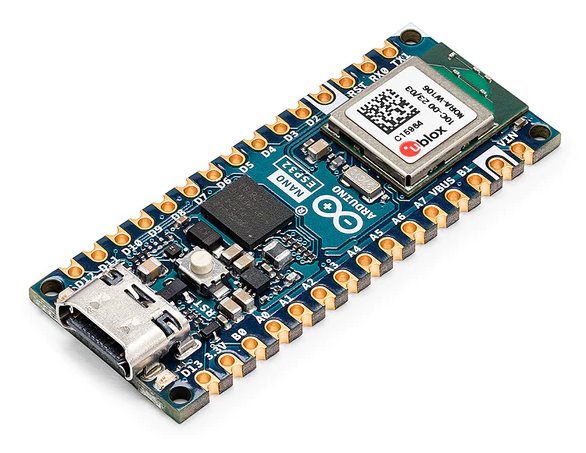Products
Manufacturers
Applications
Arduino’s Nano ESP32 board combines two giants of the industry to bring developers the benefits of Arduino and Espressif’s ESP32 ecosystems in a compact form factor of just 45 x 18 mm. In addition to a powerful ESP32-S3 heart with WiFi and Bluetooth connectivity to match, the Nano ESP32 supports additional MicroPython programming options and HID functionality, meaning that it can be used as a mouse or keyboard via the USB-C programming/interfacing connector. This board is also compatible with Arduino Cloud for remote monitoring and control.
With options for a castellated, single-sided board or a board with pre-soldered headers, this board can be easily integrated into designs to create wearables, miniature robotics, IoT devices, games consoles, and so much more. Please note that unlike many Arduino boards, the Nano ESP32 operates at 3.3 V and is not suitable for direct I/O interfacing with 5-V systems.
The Nano ESP32 is built around the NORA-W106 module from u-blox, which contains the ESP32-S3 processor and an in-built antenna to support WiFi and Bluetooth connectivity with up to 150 Mbps data transfer rate. This device can run at up to 240 MHz and is supported by 384 kB ROM, 512 kB SRAM, and 128 Mbit external flash memories. Additional functionality includes low power modes for 7 μA current draw in deep sleep mode and 240 μA current draw in light sleep mode, making the Arduino Nano ESP32 great for always-on battery-operated, wirelessly connected designs. With careful optimisation, the ESP32-S3 is also capable of running AI applications – See the ESP32-S3-BOX for a dedicated smart home AIoT development kit.
An additional feature specific to Espressif’s devices is the ESP-NOW wireless communication protocol, which allows for efficient, low-latency direct communication – i.e., without a central server or access point – between two ESP32 devices; ESP-NOW supports a payload of up to 250 bytes. Each Espressif device has a unique MAC address that is used to identify the receiving board, and this allows designers to set up one-way or two-way communication between a pair of Arduino Nano ESP32 boards. This makes it much easier to create paired systems such as remote-control cars/drones or interactive IoT devices.

As shown in the diagram above, the Nano ESP32 board features 30 pins that include the following control and interfacing options:
- 22x digital I/O pins at 3.3 V (14 dedicated)
- 8x analogue input pins at 3.3 V
- 5x PWM pins (max from any I/O pin)
- UART, I2C, I2S, SPI, and CAN interfaces
- +3.3 V and VUSB output pins for reference or powering external devices
- 2x GND pins
- 1x Reset pin
- 3x LEDs: One to indicate power to the device (green), one user LED (yellow), and one RGB LED
- A reset button
The Arduino Nano ESP32 can be powered via USB or 6-21 V input to the VIN pin. The power consumption is predominantly set by the number of I/O pins in use; the source current per I/O pin is 40 mA, and the sink current is 28 mA.
For more information on this board, please consult the official datasheet.
If you would like to evaluate the Arduino Nano ESP32 for a commercial project, fill out the form below, and ipXchange will put you directly in touch with our Arduino contact after assessing your project. For a more basic board that features the same form factor with 5-V logic, consider the Nano Every.
(Images sourced from Arduino)
